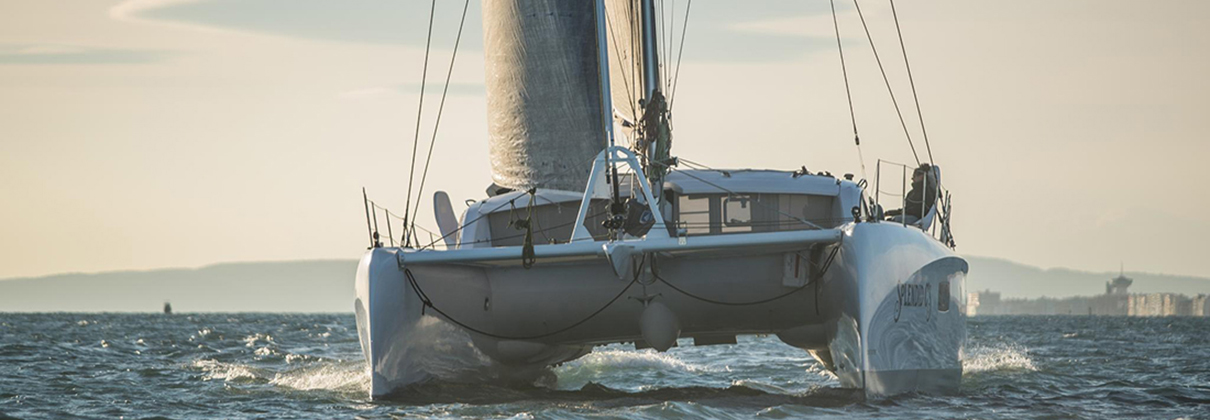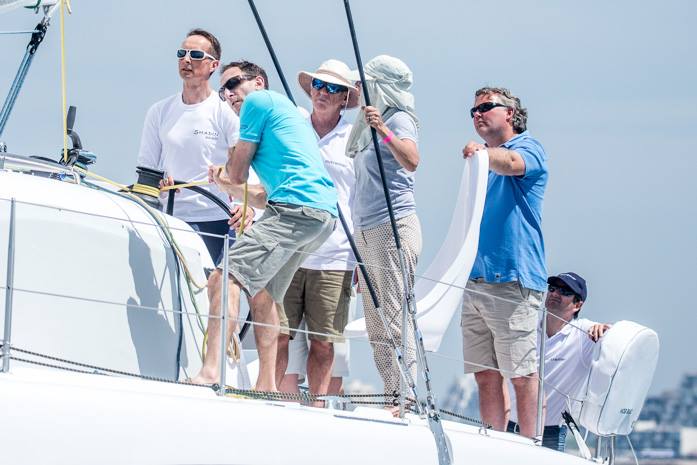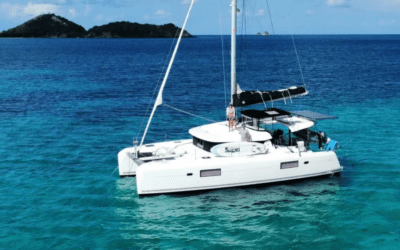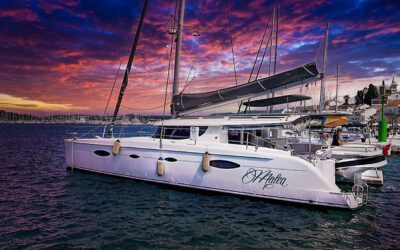
Advantages and Disadvantages Of Catamarans
ADVANTAGES
- The angle is better. Instead of the usual 30-45 degrees heeling on a monohull, you are more likely to be sailing at a comfortable 5-10 degrees. This eliminates the fatigue factor which benefits both safety and comfort. Not to mention the fact that items are not falling over or off counters underway – an added bonus.
- Expanded cruising grounds. Due to a shallow draft of 1 – 5 feet (depending on whether your catamaran has fixed keels or retractable daggerboards), you can cruise or anchor in places few monohulls can even contemplate.
- Comfortable anchoring. Linking to the point above, due to the fact that catamarans can anchor in shallow areas, this usually also means that they can find sheltered areas avoiding swells and ultimately leading to a very calm sleep.
- Create your own haulout. Sometimes, finding a suitable haulout to scrape off any barnacles or do some bottom maintenance work is few and far between, but a catamaran can comfortably sit on its own keels while you are able to perform any necessary work. All you need to find is a level anchorage with a big swing tide.
- Space, space, space. Space to walk on deck, space to lounge in an expansive cockpit or hammock-type trampoline, extra deck space on a flybridge, space for storage, space to sleep, space, space, space…even space from each other when needed…
- Leading on from the point above, having two hulls allows for extra privacy when needed. Where can you think of traveling with two families, each having their own hull?
- Most catamarans have 360 degrees views from both the cockpit and the saloon. One can easily see what is happening while underway, at anchor and can enjoy views at all times (it’s a great improvement from the often claustrophobic monohull cockpit or cavern saloon).
- Catamarans don’t sink. The general rule of thumb for catamaran goers is that if you have an emergency at sea, the best policy is to stay with your catamaran. If a catamaran is damaged, or in very few extreme cases actually flips, the vessel will float indefinitely (right side up or not). The fact that most catamarans are made from closed-cell foam will cause it to float, no matter what. The larger floating vessel will be easier to spot by any search and rescue crew. The only exception to the rule would be a fire onboard, in which case you really would need your life-raft. Generally, due to the fact that catamarans are generally faster than monohulls, which leads into the next point, catamarans can actually out-run a storm, get out of the way, and it is always good to try to avoid a bad thing.
- Catamarans are faster. Not all catamarans are created equal. Some are built with chartering or comfort cruising in mind and so may have extra headroom (extra windage) and extra living space and amenities (some extra weight). On the other hand, those catamarans built for speed, generally (but not always) have less living space merely because the hulls are generally sleeker for more speed. Depending on what you are ultimately looking for in a catamaran, will determine the model of catamaran you choose. But either way, the speed on a catamaran far outweighs the speed on a monohull – generally 20-30% faster than a monohull of the equivalent size. An average speed of 8 knots in 16 knots of wind is good anytime…On another note, because the speed on catamarans is directly related to a load of wind force on the rig, catamaran crews need to be aware of the wind speeds and reef early when appropriate to keep the vessel sailing flat. A properly reefed catamaran will perform at its best.
- Double the hulls mean double the engines. Most catamarans have two engines, one in each hull. Ever have your engine break down on you when you most needed it? On a catamaran, this would not be as catastrophic with a backup engine. The two engines also make for easy maneuvering – allowing one to pivot the catamaran almost on its own axis in tight places.
- And one more added bonus reason. Resale value. You are not the only person looking to change from a monohull to a catamaran for the reasons stated above. So it only makes sense that when it comes time to sell your catamaran, you will have a buyer waiting to take over the dream. Demand for catamarans outweighs monohulls and generally, catamarans sell for a greater percentage of their purchase price than monohulls. Enough said.
DISADVANTAGES
- Feeling like you’re sailing. Catamarans don’t ‘feel’ the wind, they ‘use’ the wind. If you just have to feel the heel, then perhaps the monohull is still your best bet – it all comes down to preferences and priorities.
- A catamaran has a light displacement and a windage factor, which can make tacking tricky. But just as catamarans are different to monohulls, there are different sailing techniques to accomplish the same task. You simply carve a turn.
- A catamaran cannot point as high as a monohull. Bearing off a few degrees will not only alleviate the uncomfortable choppy ride but will also give you added speed. Catamarans enjoy sailing off the wind with speeds of about 50% of true wind, so you could possibly still arrive at the destination ahead of the monohull.
- Load carrying. Yes, catamarans should not carry too much load without affecting overall performance. As long as one loads the catamaran in a balanced manner, this should reduce any negatory effect to some extent.
- There is some slamming. Any catamaran goer who says their catamaran does not slam is lying. Slamming occurs when going into weather and the waves hit the bridge deck of the catamaran. It always sounds worse than it is and is more a question of comfort than structure. Slamming it directly related to the height and design of the bridge deck. Bridge decks are no longer low and flat, buy higher and designed to allow for the waves that pitch at the bow to taper naturally as they progress under the bridgedeck and out the stern.
Dockage is more expensive for a catamaran. True. Catamarans can take up double the space of a monohull. Due to the popularity of catamarans over the years, there are very few, to none, marinas where there is not a dockage space for a catamaran. You will always have space, just a little more expensive. Otherwise, just go around the corner and anchor off in the protected shallow bay…for free.




